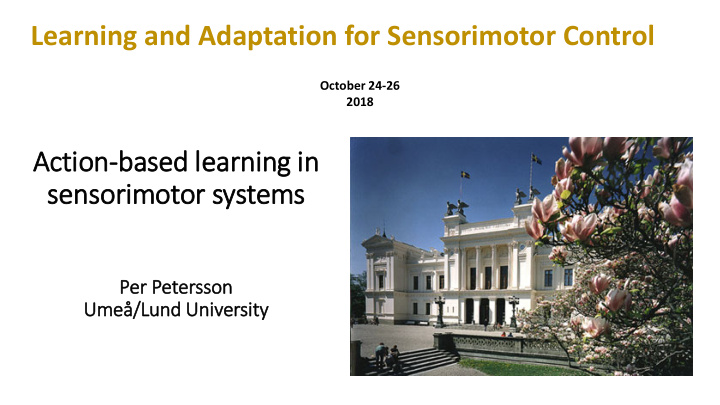



Learning and Adaptation for Sensorimotor Control October 24-26 2018 Action on-based ed l learning i in sensor orimot otor or systems Per P Pet etersso son n Umeå Um eå/Lund Uni Universi sity
What can we learn from action-based learning in biological systems? n= 800 000 Levine et al., Google Inc.
The nervous system guides our actions in a complex world
But first, the nervous system needs to learn about the own body Lambert et. al 2012 -How do different motor commands map onto patterns of sensory feedback? Vesalius, 1543 Swanson 1998
Spinal reflexes as a model system for the learning of sensorimotor transformations Descartes, 1664
In the 90s, Jens Schouenborg and co-workers demonstrated that withdrawal reflexes have a modular organization – defined by the mechanical action of single muscles Withdrawal fields Receptive fields (EMG) Apps&Garwicz, 2005
Neurons in the deep dorsal horn of the spinal cord have receptive fields that perfectly match the withdrawal fields/muscle receptive fields If these neurons are encoding the reflex patterns – how have they learned the very precise input-output relations? Is experience-dependent learning an efficient strategy for nociceptive processing? Can tactile input be used –> multimodal integration Schouenborg 2008
Tactile and nociceptive afference is mediated by different nerve fibers – but the input to the dorsal horn is aligned somatotopically Early in life tactile input appears to reach also superficial laminae Levinsson et al. 2002 Cells deeper in the dorsal horn may be multi-modal Granmo et al. 2007
Suggested simple network architecture Could self-organize via local Hebbian-like synaptic learning rules Positive feedback Petersson et al. 2003
Simulations replicate the gradual functional adaptations that occur during development Horizontal tail withdrawals But what kind of spontaneous motor activity is mediating these reflex adaptations? Petersson et al. 2003
Spontaneous movements during sleep Blumberg et al
Can the tactile feedback associated with sleep twitches be manipulated?
Withdrawal reflexes tested before and after a few hours of air-puff conditioning
What about supraspinal structures? Cerebellum Purkinje cell climbing fiber receptive fields closely match muscle receptive fields ‘Cerebellar modular organization’ Apps&Garwicz 2005 Sensorimotor cortex Bursts of cortical activity occur following spontaneous muscle twitches McVea et al. 2012
Receptive fields of cells in monkey motor cortex reflects the biomechanical action of that cell induced by microsimulation Rosén&Asanuma 1972
Developmental adaptations = learning? Is it possible to induce similar experience-dependent adaptations in the adult nervous system by excessive training?
Experimental challenges: + Behavioral training – task suitable for a rodent, motivation etc. + Detail descriptions of kinematics in freely moving animals + Recording of brain activity in distributes brain circuits
Detailed kinematics from mathematical image analyses Palmer et al. 2012
Large-scale parallel neuronal recordings in cortico-basal ganglia circuits x 128 ‘Action-selection’ ‘Reinforcement learning’ - Encodes both policies and values
Mapping of tactile receptive fields in different motor structures after excessive training for 3 weeks Example of RF change resembling Rosén&Asanuma 1972 … work in progress – but so far only MI display clear RF changes
+ This type of sensorimotor adaptations are most useful in systems that allow for single-muscle control + May not be so common in higher motor systems - Perhaps the basal ganglia are not encoding actions at his level + In many situations detailed somatosensory feedback is less important since we can rely on learned actions/habits -Sufficient to get information about the current motor state ‘Open- or closed-loop’ motor control Let’s study a natural rodent behavior that appears to be more habitual and ‘open-loop’
How do we build actions sequences consisting of several discrete motor programs?
Action sequences are in fact quite variable Are cortico-basal ganglia circuits controlling actions sequencing in this spontaneous behavior? Action selection filter…
Strong encoding of start and end of a full sequence
Phase transitions within a sequence DLS dynamics scales with P(transition) Phase transition events are primarily encoded in MI
Different systems (‘levels’) for sensorimotor integration and action selection + Spinal cord - reflex modules - functionally adapted by experience + Cerebral cortex - grasping modules - functionally adapted by experience* *) preliminary data + Basal ganglia (dorsolateral striatum) – state-dependent motor commands in actions sequences - building-blocks of habits - What about the more general case? Interaction with novel/familiar objects in the external world
Action-selection based on on-line sensory cues Multimodal sensory Motor plans information (e.g. PFC) (e.g. PPC) Action selection (e.g. Striatum) Prediction: In an action-based frame-work the sensory representation of objects in the external world should be heavily influenced by our prior knowledge of how to interact with them affordances Kjellström et al 2011
Pär Halje Ulrike Richter Jens Schouenborg Ivani Brys Marcus Granmo Martin Tamtè Alexandra Waldenström Nela Ivica Christer Fåhraeus Joel Sjöbom Tobias Palmér
Recommend
More recommend